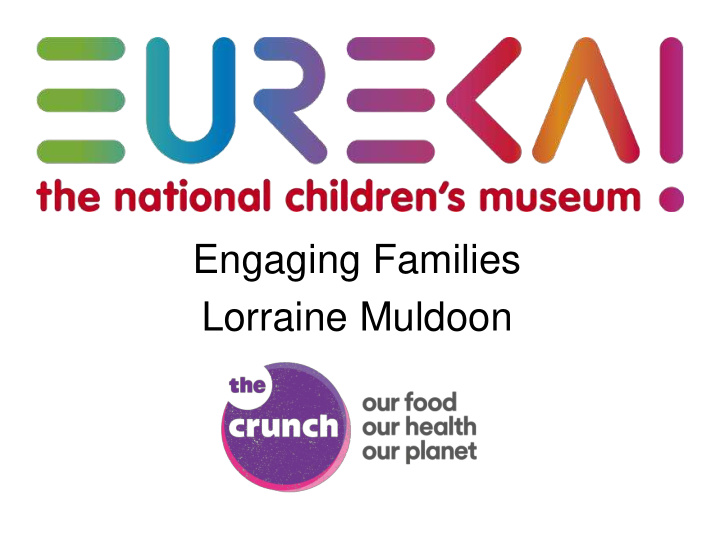



Engaging Families Lorraine Muldoon
Our approach • Make it a multi sensory experience. • Use stories. • Use games. • Include the whole family. • Use a variety of activities.
Rolling oats No; you need to roll them between Where food comes from the rollers to Food and your health flatten them. They’re still the whole grain so they’re full of fibre; really good for your heart, cholesterol and your poo! These are the harvested grains; they’re called groats. Have a What is it? Have feel of one. a look. Have a Do you like feel. Can you see porridge, muesli, ROLL THE OATS. the little grains? flapjacks? Do the TAKE YOURS HOME These are oats. oats in them look – OR EAT THEM! like the groats? YUM!
Rolling Oats – The outcome Children love a multi sensory approach to learning. Let them see, touch, taste and ‘do’ if you want to really engage them.
The chocolate story Where food comes from - The future of food Shake the cocoa pod, smell and feel the cocoa beans and taste the cacoa nibs (raw chocolate). Meet the evil villains that are attacking chocolate; witches broom and frosty pod rot! Will chocolate start running out by 2020? Discover that most cocoa farmers have never tasted chocolate.
Food of the future GRASSHOPPER Although not everybody wanted to sample some delicious mealworms and crickets; many children Known as chapulines , they are and adults welcomed the opportunity. Indeed one roasted to a crunch and tossed girl spun round in excitement crying “I used to be with chilli and lime. People buy a vegetarian; now I’m an insectivore!” them at street stands and eat them like chips. Tastes salty We also bought in some protein bars made with and spicy. insect flour for the less adventurous to try.
Grinding corn and making tortillas Although the children’s contribution was only pressing the tortillas in the press, they still felt it was their tortilla they were eating – so it tasted so much better!
The ‘ Lumpie ’ bike A really fun way to find out that you don’t need to waste food. All the fruit and veg we used would have otherwise been thrown away. If little legs couldn’t reach the pedals then little hands could spin the wheels (with a little help) and mums and dads could always be relied on to add their pedal power. Once again, so healthy (we looked at all the vitamins) and so delicious when you’ve made it yourself!
Finding iron in rice krispies If they don’t come to you; you can always go to them.
Games How much water do we eat? Global cup of tea/coffee chocolate How chocolate 24,000 litres per much kilo water do we eat? Will the food on the next card use more or less water to produce? Where do all the ingredients for our cup of tea/coffee come from (including the power to boil the kettle and oil for petrol to transport it)? Higher or lower? We also had photographs of the producers- a coffee farmer in Brazil, a Russian miner, a Cuban sugar cane worker etc. Really blew their minds when the little picture discs were spread around the world.
Variety Whether in house or on outreach we took a variety of activities; which we changed on a regular basis (maybe every 30 minutes or so) so that families could be encouraged to return to the stand and try different things. The activities we used were: • • Rolling oats Pedal powered lumpie drink • • The food of the future (insects) The story of chocolate • • Global cup of tea game Iron fish/iron in cereal • • How much water do we eat Tortilla making game? • • The story of chicken Hungry City digital game • World top 10 foods (displayed all the time with real or replica examples of each to handle We used a chalk board to display ‘current activity’ and ‘coming next’; with times for the more popular activities.
Thank you Contact details: 01422 330069 lorraine.muldoon@eureka.org.uk www.eureka.org.uk
Recommend
More recommend